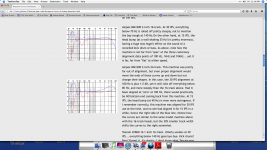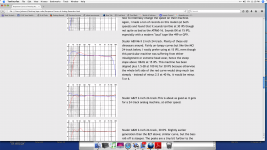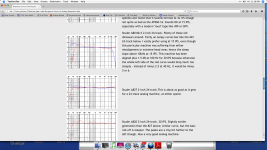🙂
And I want to say that I am very thankful that John is still here with us.
As are Erno, Nelson, Scott, Jan, Bob, Joachim, ...... from whom I have learnt a great deal.
It took me many many years before I (finally think I) really understand the complementary JFET LTP.
Unfortunately we also lost a few in the last year or two.
Patrick
I am still learning even with my 73 years behind may back.
Marry Christmas to all.
Damir
People with digital think they've hit some nirvana with all their efforts, but others haven't. Everyone who likes vinyl visits all these "nirvana" digital systems and wonders if digital will ever be as good.
Clearly subjective.
Clearly subjective.
John, you seem to be stuck in your years 70. Magnetic tapes, vinyl, integrated circuits are bad, "it was better before" etc.Enjoy your digital guys, I am going to try and fix it so that I can too! '-)
and try to get around them
If you had spend *your life* in recording studios, you had enough to suffer of the problems involved by "Analog" and try to get around them, to be vaccinated forever against those mythes.
At the precise moment you start an analog tape, you know you are no more in "direct". The hiss is obvious. the loss of instant dynamic is obvious, the distortion is obvious.
And if it is a mix, full of instruments, that you are recording, you just cry because your salad of fruits is all of a sudden transformed in some kind of smoothie. Those instruments that you were able to follow so easily suddenly melted with others (Oh, that was the reason of this name "mixer" engraved on the desk ? ;-)
When you compare direct/after analog magnetic tape, the difference in sound quality is obvious and it will not be improved by the multiple passes of the tape over the heads during re-recording...
No need of a golden ear to be 100% accurate in a direct/after tape blind test: everybody wins.
With (good) digital, I'm sure you cannot tell the difference. There can be one, but so subtle that you cannot be sure it is not your imagination.
Oh, btw, because of this transparency, you can hear all the defects, from musical clumsiness to bad recording or mixing mistakes, yes, it is true. No curtain to embellish the landscape.
May-be you like the "Euphonics" of magnetic tapes. Ok, why don"t you use your tape recorder as an effect machine, having-it inserted in your listening system like colored sunglasses, while you listen to some awful" digital" recordings, so close from the mix right out of the desk than nobody can tell the difference ?
It seems that there is two ways to consider the things. One is to try to get the maximum pleasure in your listening room, so, do and chose what you prefer, even tubes, vinyls etc... but do not talk about "fidelity".
The second is to find the more transparent system you can, to listen to the music the closest to the original as possible, whatever the defects in the original. Chose your poison, the both are respectable, and happy Christmas.
Last edited:
I don't know if John has heard the best digital. We know he has an Oppo CD player, but details are missing about whatever other data converters he may have carefully evaluated. I think he said he has an ESS 9038 evaluation board, but even if so, the best implementations are superior to the evaluation boards. Also, don't know what source material he plays with it, 16/44?
Last edited:
I don't like tube sound myself.
But I fully respect people who prefers them to solid state.
And that is way before the 70's.
So why could we not just accept other people's personal choice;
and have to argue with / convince others about our own apparent "universal truth" ?
Patrick
But I fully respect people who prefers them to solid state.
And that is way before the 70's.
So why could we not just accept other people's personal choice;
and have to argue with / convince others about our own apparent "universal truth" ?
Patrick
Indeed, subjective preference is fine; all sensory experiences are personal and subjective. It's only a problem when someone says x or y is objectively better and provides no evidence for this, or suggests someone else simply can't hear what they hear with the implication that they hear "better" - when in actuality we all hear differently.
The source material we all listen to is likely very diverse (and that's a good thing!) but can leave you trying to compare apples and pears!
The source material we all listen to is likely very diverse (and that's a good thing!) but can leave you trying to compare apples and pears!
Last edited:
Hi Patrick,
I don't care what the technology is, solid state or tube, just as long as it's done well. I'll listen to either and have both system types.
-Chris
I don't care what the technology is, solid state or tube, just as long as it's done well. I'll listen to either and have both system types.
-Chris
When you compare direct/after analog magnetic tape, the difference in sound quality is obvious and it will not be improved by the multiple passes of the tape over the heads during re-recording...
The second is to find the more transparent system you can, to listen to the music the closest to the original as possible, whatever the defects in the original.
The difference between master tape and direct is easily noted.... even with single pass - no overlay, rerecording etc). However, Master tape to vinyl is a much larger degradation. One other reason I went to making my own masters is to know what it actually sounded like compared to the tape.... I was there to listen as well as record. And, then on playback, I know what it should sound like.
Happy holidaz, Waly and all.
THx=RNMarsh
Last edited:
At the end of the audition, there were some very rational and open technical discussions, without egos and emotions.
And I remember one of the statement was that digital crossover was great for development.
But once done, it would still be better to rebuild the crossover / filter in analogue.
"Analogue simply sounds better."
And that was from a gentleman building digital crossover himself.
You do hear this a lot. And I do have some Linkwitz cross over board juuust in case, but I do wonder if you could really setup an apples for apples comparison. I came to the conclusion that the better one will be the one you believe in so no point debating it.
Of course analog will stop you falling down the rabbit hole of correcting everything half to death and getting obsessive about things that don't matter 🙂
Merry happy Solstice to all
No, the Ampex ATR10x series is NOT careful on tape, it can be extremely hard on tape and disasters have happened (to master tapes). It can and does move the tape over the heads extremely well and consistently (the goal of tape transports) when everything is proper. But the Studer master tape recorders are safer and easier on tape, and they have many safeguards for tape handling built into them.
Low Freq tape bumps are a factor of the physical head design. I know of no production tape deck that actually reduces the lf head bump, they move the tilt of the low end but do not change the shape of the bumps. ie +2 and -0 can become +/- 1, the amount of bump is the same, just displaced.
for best references see the MRL website that has all of Jay McKight's papers and references to many others. He is still writing new papers and continuing his life's work on tape recording and playback. Magnetic Reference Laboratory (MRL) scroll down to MRL Technical Papers Available
Cheers
Alan
No, the Ampex ATR10x series is NOT careful on tape, it can be extremely hard on tape and disasters have happened (to master tapes). It can and does move the tape over the heads extremely well and consistently (the goal of tape transports) when everything is proper. But the Studer master tape recorders are safer and easier on tape, and they have many safeguards for tape handling built into them.
Low Freq tape bumps are a factor of the physical head design. I know of no production tape deck that actually reduces the lf head bump, they move the tilt of the low end but do not change the shape of the bumps. ie +2 and -0 can become +/- 1, the amount of bump is the same, just displaced.
for best references see the MRL website that has all of Jay McKight's papers and references to many others. He is still writing new papers and continuing his life's work on tape recording and playback. Magnetic Reference Laboratory (MRL) scroll down to MRL Technical Papers Available
Cheers
Alan
Last edited:
We were talking about "sound recorders". Nt musical instruments.Indeed, subjective preference is fine; all sensory experiences are personal and subjective. It's only a problem when someone says x or y is objectively better and provides no evidence for this, or suggests someone else simply can't hear what they hear with the implication that they hear "better" - when in actuality we all hear differently.
The source material we all listen to is likely very diverse (and that's a good thing!) but can leave you trying to compare apples and pears!
My position is that when you see on paper that:
Model A offers 10-40000Hz +-1dB, >100dB of dynamic for distortion <0.001%, 0 maintenance.
and Model B 40-20000+-2db, 75dB of dynamic for 1% distortion, >1/4h. min of maintenance each morning or at each tape change (bias, levels and response curves )...
Do-you even listen when model A is ... lot less expensive?
Or, to put things in a different light, is it really worth to talk about how to soup-up a steam engine ?
One other reason I went to making my own masters is to know what it actually sounded like compared to the tape.... I was there to listen as well as record. And, then on playback, I know what it should sound like.
THx=RNMarsh
Hi
I would love to hear some of your own master tapes, since you are one of a few that knows what it should actually sound like.
It's quite easy to digitialize it so that you can share some of your briliant knowledge.
I understand that the digital version by no means will be as good as your own mastertape, but I think a lot of people would have a lot to learn from a true genious.
THx
Reodor
I sure wish you guys were more intolerant of what you think of as high fidelity. There is little or no progress if you are all satisfied with what you listen back through. Also, if we are measuring the WRONG THINGS, perhaps our measuring equipment, no matter how sophisticated, might not give us much more real info. We should find out what makes a DIFFERENCE rather than what just measures well.
It's a useful measure, but should not really be called dynamic range, which has a well defined existing meaning.
Isn't that called crest value? DR is S/N+headroom. The loudness wars have reduced DR to the same value as S/N. there is no more headroom.
Anatech, I confused the issue when I brought up the Q of a reproduce head. You measure the Q of the head with frequency to discern its NOISE contribution, not its frequency response. I first brought it up hoping to show that a secondary aspect of low head Q was an actual rolloff of the high frequency signal as well, but it has nothing to do with head resonance.
To clarify: The Q of the head is composed of its series resistance (both physical and that effectively added by eddy current loss) in series with the inductive impedance of the head with frequency. When they are roughly equal you have a Q of 1. A Q of 10 is much better, but more expensive to achieve.
If you put a reproduce head on a Q meter, you will find increasing Q with frequency at first, because the inductive impedance is increasing linearly and the fixed series resistance should stay fixed, but above a few KHz the Q will peak and then start to drop, because the eddy current loss will start to dominate. At 20KHz, I have measured a Q of 1 with the Ampex 440, and that means that the head itself is generating noise itself from its own eddy current loss, enough to be easily measurable even with tape included.
Resonant Q is another matter, and I have to agree that below 30ips, perhaps should be included to compensate for gap and spacing losses. However, at 30 ips, it only serves to limit the high frequency capability of the recorder, unless the resonance is put into the ultra-sonic region, let's say 30-40KHz.
To clarify: The Q of the head is composed of its series resistance (both physical and that effectively added by eddy current loss) in series with the inductive impedance of the head with frequency. When they are roughly equal you have a Q of 1. A Q of 10 is much better, but more expensive to achieve.
If you put a reproduce head on a Q meter, you will find increasing Q with frequency at first, because the inductive impedance is increasing linearly and the fixed series resistance should stay fixed, but above a few KHz the Q will peak and then start to drop, because the eddy current loss will start to dominate. At 20KHz, I have measured a Q of 1 with the Ampex 440, and that means that the head itself is generating noise itself from its own eddy current loss, enough to be easily measurable even with tape included.
Resonant Q is another matter, and I have to agree that below 30ips, perhaps should be included to compensate for gap and spacing losses. However, at 30 ips, it only serves to limit the high frequency capability of the recorder, unless the resonance is put into the ultra-sonic region, let's say 30-40KHz.
You were getting confused between your identities, Waly.Hi
but I think a lot of people would have a lot to learn from a true genious.
Or this new one was just created in order not to honor your promises ?
Last edited:
What the DR plugin spits out is a lot closer to crest factor than actual dynamic range. I was disappointed when I first used it, but it's a useful indicator. But you can get the same indication with a lot of music just looking at the VU meter (at least in foobar). If that goes above -12 then things sound flat. Sadly a lot of new releases over many genres fall into that category.
A couple of LPs appeared today which I chose based on high scores on the DR database. I will listen and report back. I live in hope that one of them I would want to listen to a second time 🙂
A couple of LPs appeared today which I chose based on high scores on the DR database. I will listen and report back. I live in hope that one of them I would want to listen to a second time 🙂
JC
While I find Jack Endio's web page useful to illustrate the differences and general shape of low freq head bumps, I have found that many of his graphs do not match what I have measured in my work. The Otari MTR90 responses vastly overstate any head bump that I have ever measured, while they tend to have more bump than many others, they are never that exaggerated.
Response Curves of Analog Recorders
Your eq comp does give better 30 ips play than most, excluding certain John Stephens 821B's, which I have measured as flatter than what you present and extending to 24 hz at 30ips. Note that this is not true for all 821B's as he kept changing the circuitry and you can't know just by model number what you are looking at with a Stephens.
Those graphs are useful for comparative purposes, they are not to my opinion and experience accurate.
Cheers
Alan
While I find Jack Endio's web page useful to illustrate the differences and general shape of low freq head bumps, I have found that many of his graphs do not match what I have measured in my work. The Otari MTR90 responses vastly overstate any head bump that I have ever measured, while they tend to have more bump than many others, they are never that exaggerated.
Response Curves of Analog Recorders
Your eq comp does give better 30 ips play than most, excluding certain John Stephens 821B's, which I have measured as flatter than what you present and extending to 24 hz at 30ips. Note that this is not true for all 821B's as he kept changing the circuitry and you can't know just by model number what you are looking at with a Stephens.
Those graphs are useful for comparative purposes, they are not to my opinion and experience accurate.
Cheers
Alan
- Status
- Not open for further replies.
- Home
- Member Areas
- The Lounge
- John Curl's Blowtorch preamplifier part II


